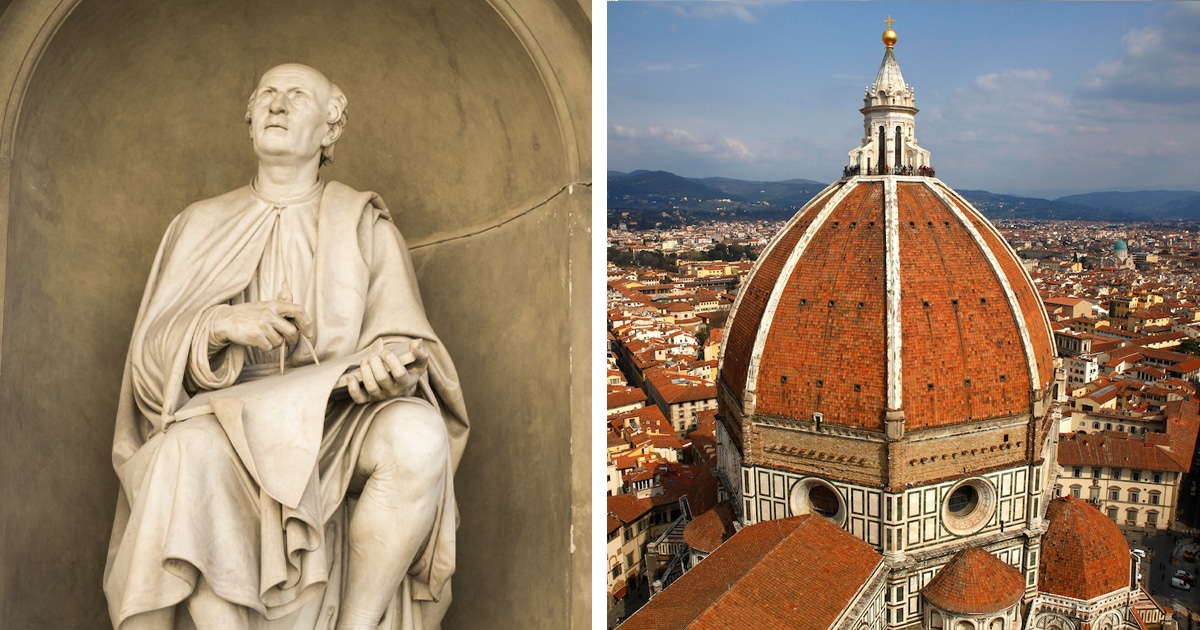The first great master of Renaissance architecture: Who is Flippo Brunelleschi?
Brunelleschi's first important work is the dome of the Church of Santa Mana del Fiore, also known as the Florence Cathedral.

(1377-1446) Italian, architect. He is the first great master of Renaissance architecture. He was born in Florence. Both his mother and father came from good families. Despite his father, who wanted him to choose one of the professions of father or grandfather, such as notary public or surgeon, he apprenticed to a jeweler. He progressed in a short time with his interest in art and his creative mind and became a good jeweler and sculptor. In 1398, he was accepted into the sericulture guild. He started working for a goldsmith in Pistoia, making the silver altar of the Pistoia di San Jacopo Church. In 1401 he participated in the competition to design the gate of the Florence Baptistery; but by a narrow margin, Ghiberti's proposal came first. Brunelleschi, meanwhile, had become friends with Donatello. They went to Rome together to examine Roman-era sculptures. Brunelleschi was also very interested in the ruins of ancient Roman buildings he encountered here, he made surveys of them. In 1404, his mastery was confirmed and he was accepted into the goldsmiths' guild. In the following years, he turned to architecture entirely. In 1433, he went to Rome for the second time to continue his studies on ancient structures. He died in Florence in 1446, where he built almost all of his works, and was buried in the Church of Santa Maria del Fiore.
Brunelleschi's first important work is the dome of the Church of Santa Mana del Fiore, also known as the Florence Cathedral. The church was an unfinished building that Arnolfo di Cambio started to build in the Gothic style around 1295, with its abbey uncovered. It took a long time and attempts were made to finish it. Finally, in 1420, experts summoned from European countries met in Florence to discuss various proposals for solving the problem. Although it was strange at first, it was decided to implement Brunelleschi's proposal. Brunelleschi enlarged the apse section of the cathedral with three semicircular niches that protrude from three sides and covered the apse with a dome that he placed on an octagonal drum. He had a large round window on each wall of this drum. The structure of the dome was formed by pointed arches sitting on the corners of the drum. An octagonal lantern rose from the top of the double-walled dome. Although it is claimed that there are gothic traces in this dome, it is also a fact that it is the first example of its kind that will become an integral part of the Renaissance city silhouette in the future with its elegant shape and the lantern crowning its top. With its diameter equal to that of the Pantheon, this magnificent dome causes the cathedral, which actually has a longitudinal axis plan, to be perceived as an almost central structure. Brunelleschi brought both formal and technical solutions to many problems of the central plan, one of the most important building schemes of the Renaissance, such as double-walled dome construction, connecting the side niches to the middle space, and the dome lantern. This technique, used in all Renaissance and Baroque domes, can in principle be considered the forerunner of today's prestressed concrete.
The Orphans' House, the construction of which began in 1421, is arguably considered the first structure of the Renaissance. The program of the building, which is the foundation of the sericulture guild, of which Brunelleschi is a member, conforms to the scheme of the medieval monasteries. Its plan consists of spaces gathered around a colonnaded central courtyard. This inward-looking building mass is lightened by a columned gallery on the front that opens to the street. This gallery is the part of the building where the basic characteristics of the Renaissance are collected. Delicate columns of Tuscan-Corinthian mixture, whose intervals are kept quite wide, are connected to each other with cradle arches.
In the same years, Brunelleschi also made the sacred objects section of the Church of San Lorenzo. How he kneads pure geometrical forms while shaping the building is also seen here.
The Church of Santa Maria degli Angeli, built by Brunelleschi after his second visit to Rome in 1433, is the one that bears the most traces of Antiquity among his structures. With its plan consisting of an octagonal central space surrounded by niches, this church is also known as the first true central building in the Renaissance. It was designed to be covered with a single-walled dome, and its construction was left unfinished before the main walls were completed.
Although Brunelleschi is considered the first architect of the Renaissance, he grew up knowing the architecture of the Middle Ages. The dome of Florence Cathedral, his first work, contains gothic features in many respects. Under the influence of the new worldview, which started to spread during his lifetime and would later be called the Renaissance, Brunelleschi also turned his eyes to the Roman civilization, which was thought to be the whole of the ancient world in those days, and examined the architecture of this civilization in depth.
Like all the early Renaissance architects, Brunelleschi paid attention to both the clear demarcation of the space as a whole, with clear boundaries, and the arrangement of each of the sub-space units within this whole in a way that would form a whole in itself.
-----------------------------------------------------
10 Facts About Filippo Brunelleschi and His Famous Dome of Florence
https://mymodernmet.com/filippo-brunelleschi-dome/
Filippo Brunelleschi: The Father of Renaissance Architecture
https://www.thecollector.com/filippo-brunelleschi-the-father-of-renaissance-architecture/
